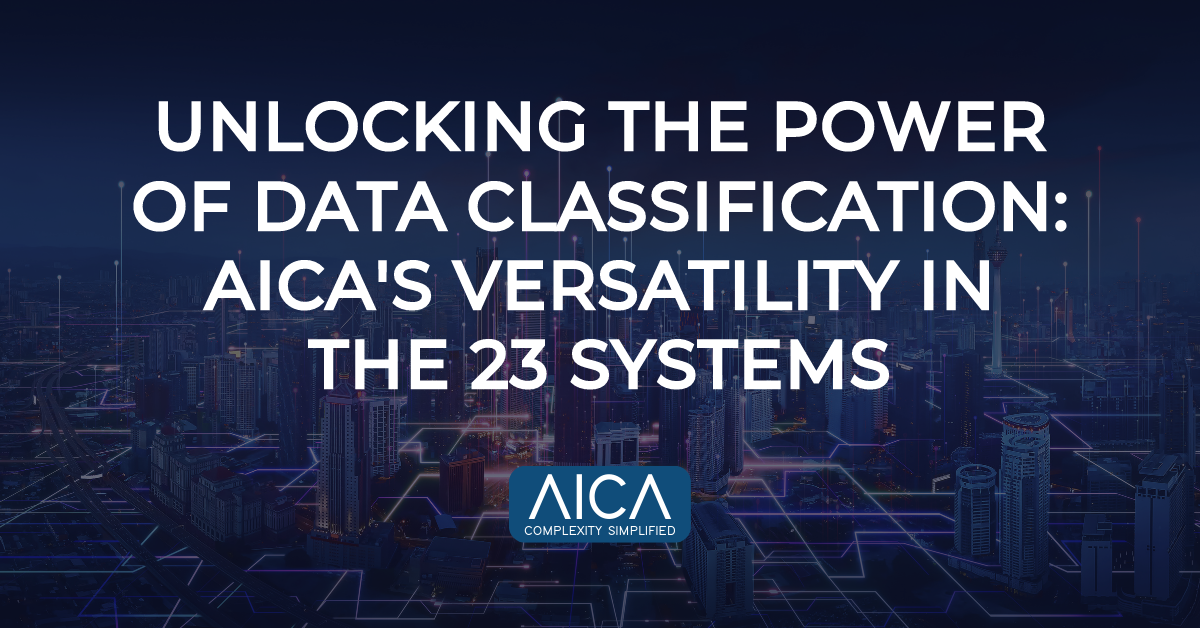Businesses rely heavily on accurate and organised data to make informed decisions, optimise processes, and gain a competitive edge. However, with vast amounts of information generated daily, keeping data well-organised and classified is no easy task. This is where AICA, a specialist in product and service data cleansing, steps in. With our ability to classify data into 23 systems as well as the ability to look at and build customised classification systems which can be end-user specific, we play a crucial role in enhancing data accuracy and streamlining operations.
The Importance of Data Classification
Data classification is the process of categorising information into specific groups or classes based on predefined criteria. It is a foundational step in data management, as it brings order to chaos and allows businesses to extract meaningful insights from their vast datasets. Here are some key reasons why data classification is vital:
Enhanced Data Accuracy: Classifying data ensures that each piece of information finds its rightful place. This accuracy is fundamental in avoiding errors, redundancies, and inconsistencies, which can have serious implications on decision-making.
Efficient Data Retrieval: Properly classified data is much easier to search, retrieve, and analyse. Teams can quickly access the information they need, improving overall productivity and response times.
Regulatory Compliance: Different industries are subject to specific regulations regarding data handling and privacy. Proper classification helps ensure compliance with relevant laws and standards, minimising legal and financial risks.
Improved Decision-Making: Accurate and well-organised data provides valuable insights that drive better decision-making at all levels of the organisation. This leads to more informed strategies and actions.
Streamlined Processes: Properly classified data allows for the automation of tasks and workflows, reducing manual efforts and boosting operational efficiency.
The Dangers of Wrongful Data Classification
The consequences of leaving data wrongfully classified can be far-reaching and detrimental to a business. Here are some potential effects:
Inaccurate Decision-Making
Misclassified data can lead to inaccurate analyses and ill-informed decisions. This can harm a company’s performance and profitability.
Poor Customer Experience
Incorrectly classified product information may lead to confusion for customers, resulting in dissatisfaction and potential loss of trust.
Non-Compliance
Wrongful classification may lead to non-compliance with industry regulations, exposing businesses to legal and reputational risks.
Data Security Risks
Improper classification can compromise data security, leading to unauthorised access and potential data breaches.
AICA’s Versatility in Data Classification
Our expertise lies in our ability to classify data into 23 distinct systems, each tailored to meet the specific needs of various industries and sectors.
1. United Nations Standard Products and Services Code (UNSPSC)
2. European Technical Information Model (ETIM)
3. Harmonized System (HS)
4. North American Industry Classification System (NAICS)
5. Standard Industrial Classification (SIC)
6. Universal Product Codes (UPC)
7. Global Trade Item Numbers (GTIN)
8. Medical Subject Headings (MeSH)
9. General Service List (GSL)
10. Central Product Classification (CPC)
11. International Standard Industrial Classification of All Economic Activities (ISIC)
12. General Transit Format (GTF)
13. International Standard Book Number (ISBN)
14. United Nations Standard Products and Services Code for Construction (UNSPSC-C)
15. European Article Number (EAN)
16. Automotive Aftermarket Industry Association (AAIA) Product Classifications
17. Global Product Classification (GPC)
18. International Classification for Standards (ICS)
19. International Standard Industrial Classification for Fishing, Forestry, and Related Activities (ISIC-FR)
20. North American Product Classification System (NAPCS)
21. International Patent Classification (IPC)
22. Advanced Language for Product Classification (ALPC)
23. Global Industry Classification Standard (GICS)
AICAs Use Of Machine Learning
We leverage the power of machine learning algorithms to efficiently classify customers data. Our ML algorithms are trained on vast amounts of labelled data, enabling them to recognise patterns and relationships within the data.
These algorithms automatically learn and improve over time, allowing us to handle large-scale data classification tasks with speed and accuracy.

